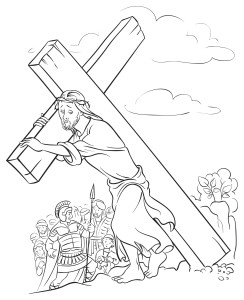Crucifixion – How much can children understand?
I would like to write a children’s picture book about Easter, but I keep stumbling over this question, “How much can children understand?” The message of Easter includes some really gruesome scenes leading up to and including his crucifixion. Without the crucifixion, you can’t have Easter. But how much is enough, and how much is too much?
Some parts are easy enough. We can breeze through Palm Sunday singing praises and glorifying Jesus as the Son of God, the long-awaited Messiah. But it doesn’t stay this easy.
Jesus turns the tables on the money changers and the people selling animals for sacrifice. We can emphasize the importance of Jesus’ determination to keep the temple pure and not let swindlers use the temple for buying and selling and taking advantage of the people who come to worship.
Jesus teaches in the temple using parables, but the stories make the religious leaders angry enough to want to kill him because they expose the wrong things the religious leader do. Jesus heals people on the Sabbath. The religious leaders are both angry and jealous of the attention the people give to Jesus. Children should be able to understand their hypocrisy.
The account of the Disciples meeting with Jesus in the upper room for the Passover Meal includes so much. Jesus teaches about putting others first and serving them as he washes the Disciples’ feet. He tells the Disciples that he is going to be put to death and gives them bread and wine saying this is his body and blood. He tells them to eat the bread and wine to remember him after he is gone.
We can teach the importance of staying awake to pray when we tell children about Jesus praying in the Garden of Gethsemane while the Disciples kept falling asleep.
Then it starts getting rough when Judas betrayed Jesus with a kiss. How much do children need to know at various age levels about what Jesus went through from this point up to the crucifixion itself?
Before we can decide what to include and what to leave out, we need to answer this question: What are the most important teaching points in the crucifixion and resurrection for children? I come up with these three:
- All people sin and grieve God. Jesus came to earth and willingly died to save us from our sins.
- When Jesus died on the cross, those who loved and trusted him lost all hope. Their light was gone.
- Jesus rose from his grave on Sunday morning and appeared to many people. This proved to the world that Jesus was the Son of God. Hope was restored for all who love him.
Using these three points as a framework what would you include to teach your children (or grandchildren, nieces or nephews . . .) the message of Easter? What ages are the children?
Photo copyright: regina555 / 123RF Stock Photo
For your convenience – links to Scripture passages about the week between Jesus’ triumphal entry to Jerusalem and his resurrection: Matthew 21-28 Mark 11-16 Luke 19:28-24:53 John 12:12-21:25 (John 12:12-18:40 & John 19-21)
“Enjoy this post? Subscribe by entering your email in the box at the top right of the sidebar and you won’t miss another one!”


You have given writers a lot to think about when approaching the Easter topic concerning Christ. Maybe each aspect of the Easter story could be presented from the viewpoint of someone or something present. If the view is from a small child or small animal, maybe try to get down on that level, literally. From the level of the knees, what would a small child see? The donkey walking by carrying someone. A cross being dragged through the streets. Feet on a cross. Then an empty tomb. Women’s sandals hurrying away from the tomb, etc. Maybe children can only deal with what they would actually see and that is enough for them to fill in the blanks with what they can understand.
Wow! Thank you Deb for your wonderful insights on sharing the Easter message with children. Those are great!
Deb…that makes me want to go and write that book right now!
As a child I heard it every year and while I didn’t understand the theology of the cross, I did understand the pain (skinned knee) I understood the heaviness of the cross because of lifting chicken feed. We had a teacher who was very strict but creative. I believe she had us feel an unsmoothed piece of wood. Or feeling someone pulling a sliver from your finger. We had a wonderful church. I believe God himself helped with our understanding and that of we children How to put it into a book is your talent.
Thank you for sharing Gail. Those are some good suggestions for making it real for children.